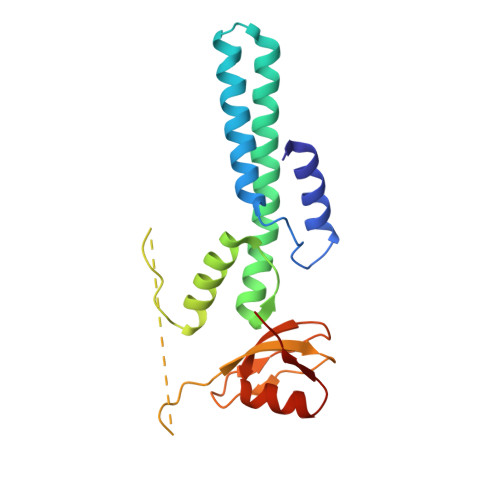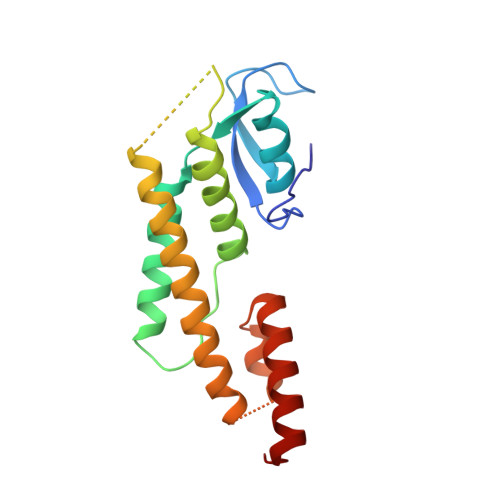Architectures of archaeal GINS complexes, essential DNA replication initiation factors
Oyama, T., Ishino, S., Fujino, S., Ogino, H., Shirai, T., Mayanagi, K., Saito, M., Nagasawa, N., Ishino, Y., Morikawa, K.(2011) BMC Biol 9: 28-28
- PubMed: 21527023
- DOI: https://doi.org/10.1186/1741-7007-9-28
- Primary Citation of Related Structures:
3ANW - PubMed Abstract:
In the early stage of eukaryotic DNA replication, the template DNA is unwound by the MCM helicase, which is activated by forming a complex with the Cdc45 and GINS proteins. The eukaryotic GINS forms a heterotetramer, comprising four types of subunits. On the other hand, the archaeal GINS appears to be either a tetramer formed by two types of subunits in a 2:2 ratio (α2β2) or a homotetramer of a single subunit (α4). Due to the low sequence similarity between the archaeal and eukaryotic GINS subunits, the atomic structures of the archaeal GINS complexes are attracting interest for comparisons of their subunit architectures and organization. We determined the crystal structure of the α2β2 GINS tetramer from Thermococcus kodakaraensis (TkoGINS), comprising Gins51 and Gins23, and compared it with the reported human GINS structures. The backbone structure of each subunit and the tetrameric assembly are similar to those of human GINS. However, the location of the C-terminal small domain of Gins51 is remarkably different between the archaeal and human GINS structures. In addition, TkoGINS exhibits different subunit contacts from those in human GINS, as a consequence of the different relative locations and orientations between the domains. Based on the GINS crystal structures, we built a homology model of the putative homotetrameric GINS from Thermoplasma acidophilum (TacGINS). Importantly, we propose that a long insertion loop allows the differential positioning of the C-terminal domains and, as a consequence, exclusively leads to the formation of an asymmetric homotetramer rather than a symmetrical one. The DNA metabolizing proteins from archaea are similar to those from eukaryotes, and the archaeal multi-subunit complexes are occasionally simplified versions of the eukaryotic ones. The overall similarity in the architectures between the archaeal and eukaryotic GINS complexes suggests that the GINS function, directed through interactions with other protein components, is basically conserved. On the other hand, the different subunit contacts, including the locations and contributions of the C-terminal domains to the tetramer formation, imply the possibility that the archaeal and eukaryotic GINS complexes contribute to DNA unwinding reactions by significantly different mechanisms in terms of the atomic details.
Organizational Affiliation:
Laboratory of Protein Organic Chemistry, Institute for Protein Research, Osaka University, Open Laboratories of Advanced Bioscience and Biotechnology (OLABB), Osaka 565-0874, Japan. morikako@protein.osaka-u.ac.jp















